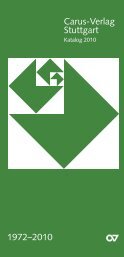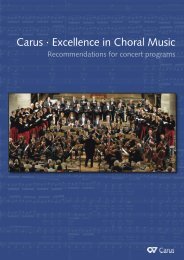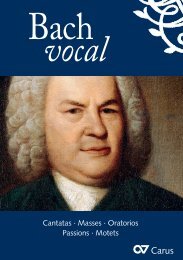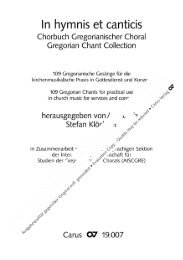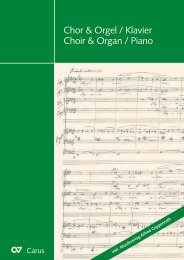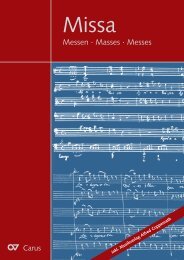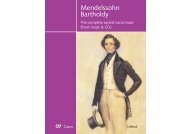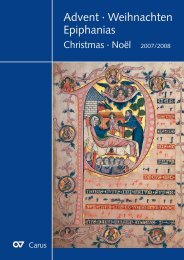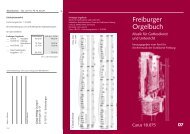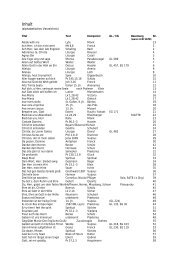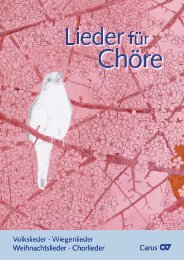Sie wollen auch ein ePaper? Erhöhen Sie die Reichweite Ihrer Titel.
YUMPU macht aus Druck-PDFs automatisch weboptimierte ePaper, die Google liebt.
Carus<br />
<strong>Mozart</strong><br />
Das geistliche Vokalwerk · Sacred<br />
vocal music · Musique vocale sacrée
Inhalt<br />
Content<br />
Table des matières<br />
Das geistliche Vokalwerk<br />
The sacred vocal works<br />
La musique vocale sacrée 5<br />
Lateinische Messen und Requiem<br />
Latin Masses and the Requiem<br />
Les messe en latin et le Requiem 6<br />
Kantaten, Litaneien und Vespern<br />
Cantatas, Litanies and Vespers<br />
Les cantates, litanies et vêpres 9<br />
Kleinere Kirchenwerke<br />
Shorter church works<br />
Les œuvres sacrées de petit format 12<br />
Intrumentalmusik<br />
Instrumental music<br />
Musique instrumentale 16<br />
Weitere Werke<br />
Miscellaneous<br />
Mélanges 18<br />
Titelbild / Cover / Illustration de couverture:<br />
Wolfgang Amadeus <strong>Mozart</strong><br />
unvollendetes Ölgemälde von Joseph Lange,<br />
1789 (27,7 x 32 cm)<br />
Internationale Stiftung <strong>Mozart</strong>eum (ISM)<br />
(Carus-Postkarte CV 40.390/10)<br />
Redaktionsschluß: 1.3.2003<br />
Carus-Verlag Stuttgart<br />
Sielminger Straße 51<br />
D-70771 Leinfelden-Echterdingen<br />
Telefon +49 (0)711-797 330-0<br />
Fax +49 (0)711-797 330-29<br />
e-mail: sales@carus-verlag.com<br />
www.carus-verlag.com<br />
Abkürzungen, Symbole<br />
Abbreviations, Symbols<br />
Abréviations, symboles<br />
( ) = Besetzungsangaben in runden<br />
Klammern sind Alternativbesetzungen<br />
Instruments in parentheses indicate<br />
alternative scoring<br />
Les instruments notés entre parenthèses<br />
désignent les autres distributions possibles<br />
[ ] = Besetzungsangaben in eckigen Klammern<br />
sind Ad-libitum-Besetzungen<br />
Instruments in brackets indicate<br />
ad libitum scoring<br />
Les instruments notés entre crochets<br />
designent les distributions ad libitum.<br />
Bläser / winds / vents 0222-2230<br />
= Holzbläser / woodwinds / bois:<br />
0 Fl, 2 Ob, 2 Clt, 2 Fag<br />
+ Blechbläser / brass / cuivres:<br />
2 Cor, 2 Tr, 3 Trb, 0 Tuba<br />
Th = Textheft / libretto / livret<br />
Pk = Postkarte / postcard / carte postale<br />
E = Englisch / English / anglais<br />
G = Deutsch / German / allemand<br />
L = Latein / Latin / latin<br />
Part Partitur · full score · partition d’orchestre<br />
KA Klavierauszug · vocal score<br />
réduction pour piano<br />
Chp Chorpartitur · choral score without<br />
keyboard reduction · partitition de chœur<br />
Harm Harmoniestimmenset · set of harmony<br />
parts · jeu de parties instrumentales<br />
* Mengenpreis · discounts · remises<br />
ab 20 Ex. 10% Nachlass / discount<br />
ab 50 Ex. 15% Nachlass / discount<br />
ab 100 Ex. 20% Nachlass / discount<br />
� unverbindlich empfohlener Preis<br />
suggested price · prix recommandé<br />
Preisänderung, Irrtum und Liefermöglichkeit<br />
vorbehalten. · Prices are subject to change.<br />
Errors excepted. · Les livraisons ne peuvent être<br />
promises que sous les réserves d’usage.<br />
Stuttgarter <strong>Mozart</strong>-Ausgaben<br />
Urtext<br />
Die Stuttgarter <strong>Mozart</strong>-Ausgaben sind Urtext-<br />
Ausgaben, die die bisherigen Editionen gemäß<br />
dem neuesten Stand der Quellenforschung<br />
kritisch hinterfragen. Alle kirchenmusikalischen<br />
Werke <strong>Mozart</strong>s sind erstmals mit komplettem<br />
Aufführungsmaterial erhältlich.<br />
Was bieten die Stuttgarter Ausgaben?<br />
– Urtext auf dem neuesten wissenschaftlichen<br />
Stand, d. h. Berücksichtigung neuer wissenschaftlicher<br />
Erkenntnisse und neu aufgefundener<br />
Quellen,<br />
– Partituren von anerkannten <strong>Mozart</strong>-Experten<br />
mit Vorwort, Kritischem Bericht und Hinweisen<br />
zur Edition und Aufführungspraxis,<br />
– gut spielbare Klavierauszüge,<br />
– käufliches Aufführungsmaterial, das den Erfordernissen<br />
der Praxis gerecht wird: Stichnoten,<br />
guten Wendestellen, Chorpartituren, Orchesterstimmen<br />
und Generalbassaussetzung zu<br />
allen Werken,<br />
– Carus-Notenstichqualität zu günstigen Preisen<br />
kurz: Wissenschaft für die Praxis<br />
Stuttgart <strong>Mozart</strong> Editions<br />
Urtext<br />
In light of the newest developments with regard<br />
to sources and editorial practice, the Stuttgart<br />
<strong>Mozart</strong> Editions (Urtext) pose critical questions<br />
concerning previous critical editions. For the first<br />
time all church compositions by <strong>Mozart</strong> are available<br />
with the complete performance material.<br />
What do the Stuttgart <strong>Mozart</strong> Editions have to<br />
offer?<br />
– Urtext founded upon the latest musicological<br />
developments: in other words, consideration of<br />
the latest musicological research and all newlydiscovered<br />
sources,<br />
– full scores with forewords, critical reports<br />
and/or remarks concerning the edition and suggestions<br />
for performance practice,<br />
– easily playable vocal scores,<br />
– performance material for all works, with cue<br />
notes and practical page turns, choral scores,<br />
orchestral parts and figured bass realizations for<br />
all works,<br />
– the excellent quality of Carus music engraving<br />
Musicology meets Performance!<br />
Éditions <strong>Mozart</strong> de Stuttgart<br />
Editée Intégralement<br />
Les Éditions <strong>Mozart</strong> de Stuttgart sont des éditions<br />
de textes originaux traitant de manière critique les<br />
éditions précédentes en fonction des dernières<br />
évolutions dans le domaine des sources. Toutes les<br />
œuvres sacrées de <strong>Mozart</strong> sont disponibles non<br />
seulement comme partitions d’orchestre mais<br />
encore – et cela vraiment pour la première fois –<br />
avec le matériel d’exécution complet.<br />
Que proposent les Éditions <strong>Mozart</strong> de Stuttgart ?<br />
– un texte original établi d’après le plus récent<br />
état des recherches, c-à-d., tenant compte des<br />
sources découvertes récemment et des connaissances<br />
acquises,<br />
– des partitions avec avant-propos et apparat<br />
critique ou remarques concernant l’édition et la<br />
pratique d’exécution, de spécialistes reconnus<br />
– des réductions pour piano aisément jouables,<br />
– un matériel d’exécution ayant fait ses preuves<br />
avec répliques et fins de pages pratiques, des<br />
partitions pour chœur, des parties d’orchestre et<br />
des réalisations de basse continue pour chaque<br />
œuvre,<br />
– la qualité de gravure des Éditions Carus à un prix<br />
raisonnable<br />
En résumé la musicologie au service de l'exécution<br />
3 3
4<br />
· Krönungsmesse<br />
Partitur<br />
Full score<br />
Organo<br />
Das Notenbild der Krönungsmesse<br />
in der Carus-Edition<br />
Music engraving of the Coronation<br />
Mass in the Carus edition<br />
Klavierauszug<br />
Vocal score<br />
Chorpartitur<br />
Choral score<br />
Missa in C<br />
KV 317 Krönungsmesse<br />
CV 40.618 siehe S. 9 / see p. 9<br />
Wolfgang Amadeus <strong>Mozart</strong>:<br />
Das geistliche Vokalwerk<br />
Urtext – komplett bei Carus<br />
Es gibt viele Belege, aus denen hervorgeht, dass<br />
sich Wolfgang Amadeus <strong>Mozart</strong> seiner kompositorischen<br />
Kunst und Bedeutung auch für die Kirchenmusik<br />
bewusst war. So etwa, wenn er betont,<br />
dass „Salieri sich nie dem kirchen Styl gewidmet<br />
(hat), ich aber von Jugend auf mir diesen Styl<br />
ganz zu eigen gemacht habe.“ Der größte Teil<br />
seiner geistlichen Vokalmusik entstammt der<br />
Jugendzeit <strong>Mozart</strong>s, in der er (seit 1769) als Erzbischöflicher<br />
Konzertmeister in Salzburg angestellt<br />
und zur Komposition orchesterbegleiteter<br />
Kirchenmusik aufgefordert war.<br />
<strong>Mozart</strong>s „kirchen Styl“ basiert auf dem Gleichgewicht<br />
kontrastierender Elemente und der Synthese<br />
von weltlicher und geistlicher Musik. Er bringt<br />
die Ansprüche von Kunst und Kultus, die liturgischen<br />
Forderungen und das künstlerische Streben<br />
nach autonomen musikalischen Formen zum Ausgleich.<br />
Dies gelingt ihm durch Übernahme von<br />
Formen, Stilen und Techniken aus dem Bereich<br />
der Oper (Arienformen, Koloraturgesang) und<br />
der Instrumentalmusik (Sonaten- und Rondoformen,<br />
sinfonischer Orchesterstil).<br />
Das Klangspektrum reicht vom A-cappella-Stück<br />
über kammermusikalisch besetzte Werke bis zur<br />
großen Komposition sinfonischen Zuschnitts, die<br />
vom konzertanten Miteinander von Soli, Chor<br />
und Orchester lebt. Der religiös-musikalische Ausdruck<br />
bedient sich sowohl des maßvollen, alten<br />
kontrapunktischen Satzes als auch der „dramatischen“<br />
modernen Tonsprache.<br />
Die ganze Breite und faszinierende Vielfalt dieses<br />
kirchenmusikalischen Œuvres – von der spätbarocken<br />
Jugendkantate bis zum meisterhaften<br />
Spätwerk – wird sichtbar und für die Praxis erschlossen<br />
durch die Carus-Ausgaben sämtlicher<br />
geistlicher Kompositionen <strong>Mozart</strong>s. Sie stellen der<br />
musikalischen Praxis das vollständige Aufführungsmaterial<br />
zur Verfügung: Dirigier- und Chorpartitur,<br />
Stimmen, Klavierauszug und auch eine<br />
separate Orgelstimme zu jedem Einzelwerk.<br />
Das hier in kritischen Ausgaben (Urtext) vorliegende<br />
Material ist von Spezialisten erarbeitet worden<br />
und spiegelt deutlich die kompositorischen<br />
und aufführungspraktischen Absichten des Komponisten<br />
– die beste Voraussetzung für eine historisch<br />
authentische Aufführung.<br />
Wolfgang Amadeus <strong>Mozart</strong>:<br />
The sacred vocal works<br />
Urtext – complete from Carus<br />
There is much evidence to show that Wolfgang<br />
Amadeus <strong>Mozart</strong> was aware of the significance of<br />
his compositional art and also of its importance in<br />
the field of church music. He wrote, for example,<br />
that “Salieri has never dedicated himself to the<br />
church style, but I have made this style entirely my<br />
own since my youth.” The greater part of<br />
<strong>Mozart</strong>’s sacred vocal music dates from his early<br />
years (from 1769) when he was employed as concertmaster<br />
to the Archbishop of Salzburg, and<br />
was required to compose church music with<br />
orchestral accompaniment.<br />
<strong>Mozart</strong>’s “church style” is based on the balance<br />
between contrasting elements, and on the synthesis<br />
of secular and sacred music. He balances<br />
the demands of art and religion, the liturgical requirements<br />
with the striving toward artistically<br />
autonomous musical forms. He succeeds in this<br />
effort by drawing upon forms, styles and techniques<br />
from the realms of opera (aria forms, coloratura<br />
singing) and instrumental music (sonata<br />
and rondo forms, symphonic orchestral style).<br />
The tonal spectrum extends from a cappella<br />
pieces by way of works for chamber ensemble to<br />
the great compositions of a symphonic character<br />
which use the full resources of soli, choir and<br />
orchestra. The religious-musical expression is<br />
created both by the grandeur of movements in<br />
the ancient contrapuntal style, as well as by the<br />
“dramatic” musical language of the day.<br />
The entire breadth and fascinating diversity of<br />
this œuvre of sacred music – from the late-baroque<br />
style of the early cantatas to the masterful<br />
later works – are made comprehensible and accessible<br />
for practical performance through the<br />
Carus editions of <strong>Mozart</strong>’s complete sacred compositions.<br />
These editions include the complete<br />
materials required for performance: conducting<br />
and choral scores, vocal score and parts and,<br />
finally, a separate organ part for each work. The<br />
present critical, Urtext editions, prepared by<br />
leading scholars in the field, clearly reflect the<br />
composer’s intention both in concept and in practical<br />
realization – this is the best basis for historically<br />
authentic performances.<br />
5
Wolfgang Amadeus <strong>Mozart</strong> :<br />
La musique vocale sacrée<br />
éditée intégralement chez Carus<br />
Il existe de nombreux documents qui prouvent<br />
que Wolfgang Amadeus <strong>Mozart</strong> était également<br />
conscient de son importance et de son talent dans<br />
le domaine de la musique sacrée, par exemple,<br />
lorsqu’il souligne que « Salieri ne (s’est) jamais intéressé<br />
au style d’église, alors que moi, je me le<br />
suis assimilé dès ma jeunesse. » La plus grande<br />
partie de la musique sacrée de <strong>Mozart</strong> fut écrite<br />
dans les années de jeunesse, alors qu’il était maître<br />
de concert de l’archevêque de Salzbourg (depuis<br />
1769) et obligé d’écrire de la musique sacrée<br />
avec accompagnement d’orchestre.<br />
Le « style d’église » de <strong>Mozart</strong> est basé sur un<br />
équilibre entre des éléments contrastants et sur la<br />
synthèse de la musique sacrée et de la musique<br />
profane. Il accorde entre eux les buts de l’art et du<br />
culte, les exigences liturgiques et le désir artistique<br />
de formes musicales autonomes. Il y arrive en empruntant<br />
formes, styles et techniques au domaine<br />
de l’opéra (arias, colorature) et à celui de la musique<br />
instrumentale (formes de la sonate et du rondo,<br />
style orchestral symphonique).<br />
Le spectre sonore va de la pièce a cappella à de<br />
grandes compositions de format symphonique vivant<br />
de la communauté concertante existant entre<br />
solistes, chœur et orchestre en passant par des œuvres<br />
ayant une distribution de musique de chambre.<br />
L’expression musicale et religieuse recourt<br />
aussi bien à la vieille écriture contrapuntique mesurée<br />
qu’au jeune langage musical « dramatique ».<br />
L’édition intégrale des œuvres sacrées de <strong>Mozart</strong><br />
aux éditions Carus permet de rendre visible et accessible<br />
à la pratique toute l’étendue de l’œuvre<br />
sacrée et sa fascinante diversité allant de la cantate<br />
de jeunesse se rattachant au baroque tardif jusqu’au<br />
chef-d’œuvre de la maturité. Elle met à la<br />
disposition du monde musical le matériel d’exécution<br />
au complet : partition de chef et de chœur,<br />
parties, réductions piano-chant et une partie<br />
d’orgue séparée pour chaque œuvre.<br />
Le matériel présenté en éditions critiques (texte<br />
original) a été élaboré par des spécialistes et reflète<br />
de manière précise les intentions du compositeur<br />
tant du point de vue de la composition que de<br />
l’exécution et constitue la meilleure garantie pour<br />
une exécution historique authentique.<br />
6<br />
Lateinische Messen (nach KV)<br />
und Requiem<br />
Die Missa brevis ist bei Wolfgang Amadeus <strong>Mozart</strong><br />
eine konzentrierte und prägnante Vertonung<br />
des vollständigen Ordinariumstextes. Der Orchesteranteil<br />
wird meist auf das „Kirchentrio“ mit<br />
zwei Violinen, Bass und Orgel beschränkt (in Salzburg<br />
üblicherweise durch drei, den Chor verstärkende<br />
Posaunen ergänzt) und in seiner Dauer<br />
durch straffe Durchkomposition des Textes begrenzt,<br />
gelegentlich mit zeitsparendem gleichzeitigem<br />
Vortrag verschiedener Textteile.<br />
Die besondere Festlichkeit der Missa solemnis<br />
entsteht aus einer Hinzunahme von Bläsern und<br />
Pauken, selbstständiger Führung des Orchesters<br />
und breiterer, zum Teil dramatisch-kontrastreicher<br />
Gestaltung des musikalischen Satzes. Die Einzelsätze<br />
werden oft motivisch oder durch Übernahme<br />
ganzer Abschnitte zyklisch miteinander<br />
verbunden.<br />
Den Jugendwerken stehen einzelne Werke aus<br />
den späteren Jahren (1782/83 und 1791) gegenüber:<br />
die große, anspruchsvolle c-Moll-Messe<br />
und das berühmte Requiem. Beide sind – aus unterschiedlichen<br />
Gründen – Fragment geblieben,<br />
werden hier aber mit Ergänzungen publiziert.<br />
Latin Masses (in KV order) and the<br />
Requiem<br />
In the hands of Wolfgang Amadeus <strong>Mozart</strong> the<br />
Missa brevis is a concise setting of the complete<br />
text of the Ordinarium. The orchestra is generally<br />
restricted to the “church trio” of two violins, bass<br />
and organ (augmented, as a rule, in Salzburg by<br />
three trombones doubling the choir), and the<br />
work is of limited duration due to the straightforward<br />
declamation of the text and occasionally to<br />
the time-saving device of the simultaneous singing<br />
of different passages of text.<br />
The special festive character of the Missa solemnis<br />
is a result of the addition of wind instruments<br />
and timpani to the orchestra, to the more independent<br />
handling of the orchestra, and to the<br />
broader, sometimes dramatic, contrasting form in<br />
the musical structure. The individual movements<br />
are often linked motivically or through the reappearance<br />
of entire sections which cyclically are<br />
connected to each other.<br />
The youthful works are contrasted by two masterpieces<br />
of <strong>Mozart</strong>’s later years (1782/83 and<br />
1791): the great, challenging C minor Mass and<br />
the famous Requiem, both of which were left unfinished<br />
for different reasons, but they are published<br />
here in editions in which these two fragments<br />
have been completed.<br />
Les messes en latin (d’après KV)<br />
et le Requiem<br />
La messe brève est chez Wolfgang Amadeus <strong>Mozart</strong><br />
une mise en musique concentrée et concise<br />
de l’intégrale du texte de l’ordinaire. La partie orchestrale<br />
se limite la plupart du temps au « trio<br />
d’église » avec deux violons, basse et orgue (complété<br />
à Salzbourg par les trois trombones renforçant<br />
le chœur) et la messe est limitée dans sa<br />
durée par une sévère composition continue du<br />
texte avec, à l’occasion, exposition simultanée de<br />
certaines parties textuelles contribuant à une économie<br />
de temps.<br />
La solennité particulière de la messe du même<br />
nom résulte de l’utilisation des instruments à vents<br />
et des timbales, d’une conduite autonome de l’orchestre,<br />
d’une organisation plus large et de l’écriture<br />
musicale, parfois riche en contrastes dramatiques.<br />
Chacun des mouvements est souvent relié<br />
aux autres de manière cyclique par des motifs ou<br />
la reprise de passages entiers.<br />
Aux côtés des œuvres de jeunesse se retrouvent<br />
quelques œuvres des années de maturité<br />
(1782/83 et 1791) : la grande et exigeante messe<br />
en ut mineur et le célèbre Requiem. Toutes deux<br />
sont restées à l’état de fragment pour des raisons<br />
diverses, mais sont publiées ici dans des versions<br />
complétées.<br />
Missa brevis in G KV 49 (47 d )<br />
Soli SATB, Coro SATB, 2 Vl, Va, Vc/Fg/Cb,<br />
Org, [3 Trb] / 22 min<br />
40.621/00 Part 16.50 €<br />
40.621/03 KA 8.90 €<br />
40.621/05 ChpS *3.50 €<br />
40.621/09 3 Harm 4.90 €<br />
40.621/11–14 4 Str à 4.40 €<br />
40.621/49 Org 11.00 €<br />
Missa brevis in d KV 65 (61 a )<br />
Soli SATB, Coro SATB, 2 Vl, Vc/Fg/Cb,<br />
Org, [3 Trb] / 15 min<br />
40.622/00 Part 11.50 €<br />
40.622/03 KA 8.50 €<br />
40.622/05 ChpS *3.50 €<br />
40.622/09 3 Harm 4.90 €<br />
40.622/11–13 3 Str à 3.00 €<br />
40.622/49 Org 8.50 €<br />
Missa in C „Dominicusmesse“ KV 66<br />
Soli SATB, Coro SATB, 2 Fl, 2 Ob, 2 Cor,<br />
2 Ctr, 2 Tr, Timp, 2 Vl, 2 Va, Vc/Fg/Cb, Org,<br />
[3 Trb] / 43 min<br />
40.613/00 Part 34.00 €<br />
40.613/03 KA 14.50 €<br />
40.613/05 Chp *5.30 €<br />
40.613/09 14 Harm 56.00 €<br />
40.613/11–14 4 Str à 4.40 €<br />
40.613/49 Org 19.90 €<br />
Missa in c „Waisenhausmesse / Orphanage<br />
Mass“ KV 139 (114 a )<br />
Soli SATB, Coro SATB, 2 Ob, 2 Ctr, 2 Tr, 3 Trb,<br />
Timp, 2 Vl, 2 Va, Vc/Fg/Cb, Org / 41 min<br />
40.614/00 Part 32.80 €<br />
40.614/03 KA 14.90 €<br />
40.614/05 Chp *4.80 €<br />
40.614/09 10 Harm 28.00 €<br />
40.614/11–14 4 Str à 3.90 €<br />
40.614/49 Org 18.50 €<br />
Missa brevis in G KV 140<br />
Soli SATB, Coro SATB, 2 Vl, Vc/Cb, Org,<br />
[3 Trb] / 17 min<br />
40.623/00 Part 21.50 €<br />
40.623/03 KA 8.90 €<br />
40.623/05 ChpS *4.30 €<br />
40.623/09 3 Harm 9.50 €<br />
40.623/11–13 3 Str à 4.90 €<br />
40.623/49 Org 12.50 €<br />
Missa in C „Trinitatismesse“ KV 167<br />
Coro SATB, 2 Ob, 2 Ctr, 2 Tr, Timp, 2 Vl,<br />
Vc/Fg/Cb, Org, [3 Trb] / 28 min<br />
40.615/00 Part 26.90 €<br />
40.615/03 KA 12.80 €<br />
40.615/05 Chp *4.30 €<br />
40.615/09 10 Harm 23.00 €<br />
40.615/11–13 3 Str à 4.50 €<br />
40.615/49 Org 12.80 €<br />
7
Missa in C Wolfgang Amadeus <strong>Mozart</strong><br />
Spatzenmesse KV 220 (196 b ) 1756–1791<br />
Ausschnitt aus dem Sanctus<br />
© 2000 by Carus-Verlag, Stuttgart – CV 40.626/03 · Die Vorschlagsfiguren der Violinen – hier im Klavierauszug<br />
wiedergegeben – haben zu dem volkstümlichen Namen der Messe geführt. / The appoggiature in the violins – shown here<br />
in the vocal score – have given the Mass its popular name.<br />
Missa brevis in F „Kleine Credomesse“<br />
KV 192 (186 f )<br />
Soli SATB, Coro SATB, 2 Vl, Vc/Fg/Cb, Org,<br />
[2 Ctr, 3 Trb] / 21 min<br />
40.624/00 Part 16.50 €<br />
40.624/03 KA 8.50 €<br />
40.624/05 ChpS *4.30 €<br />
40.624/09 5 Harm 12.50 €<br />
40.624/11–13 3 Str à 3.90 €<br />
40.624/49 Org 13.50 €<br />
83.103 CD �16.90 €<br />
Missa brevis in D KV 194 (186 h )<br />
Soli SATB, Coro SATB, 2 Vl, Vc/Fg/Cb,<br />
Org, [3 Trb] / 18 min<br />
40.625/00 Part 15.00 €<br />
40.625/03 KA 7.50 €<br />
40.625/05 ChpS *3.30 €<br />
40.625/09 3 Harm 4.90 €<br />
40.625/11–13 3 Str à 3.30 €<br />
40.625/49 Org 11.00 €<br />
83.103 CD �16.90 €<br />
Missa in C „Spatzenmesse” / Sparrow Mass<br />
KV 220 (196 b )<br />
Soli SATB, Coro SATB, 2 Ctr, Timp, 2 Vl, Vc/Fg/Cb,<br />
Org, [3 Trb] / 18 min<br />
40.626/00 Part 15.00 €<br />
40.626/03 KA 7.00 €<br />
40.626/05 ChpS *3.30 €<br />
40.626/09 6 Harm 11.50 €<br />
40.626/11–13 3 Str à 3.30 €<br />
40.626/49 Org 8.50 €<br />
8<br />
Missa in C „Große Credomesse“ KV 257<br />
Soli SATB, Coro SATB, 2 Ob, 2 Ctr, 3 Trb, Timp, 2 Vl,<br />
Vc/Fg/Cb, Org / 27 min<br />
40.616/00 Part 29.90 €<br />
40.616/03 KA 12.80 €<br />
40.616/05 Chp *4.50 €<br />
40.616/09 8 Harm 28.00 €<br />
40.616/11–13 3 Str à 3.90 €<br />
40.616/49 Org 12.80 €<br />
Missa in C „Spaur-Messe“ KV 258<br />
Soli SATB, Coro SATB, 2 Ctr, Timp, 2 Vl, Vc/Fg/Cb,<br />
Org, [2 Ob, 3 Trb] / 20 min<br />
40.627/00 Part 24.90 €<br />
40.627/03 KA 9.50 €<br />
40.627/05 ChpS *3.90 €<br />
40.627/09 8 Harm 17.50 €<br />
40.627/11–13 3 Str à 3.30 €<br />
40.627/49 Org 7.80 €<br />
Missa in C „Orgelsolomesse“ KV 259<br />
Soli SATB, Coro SATB, 2 Ctr, Timp, 2 Vl, Vc/Fg/Cb,<br />
Org, [2 Ob, 3 Trb] / 15 min<br />
40.628/00 Part 21.50 €<br />
40.628/03 KA 7.50 €<br />
40.628/05 ChpS *3.90 €<br />
40.628/09 8 Harm 17.50 €<br />
40.628/11–13 3 Str à 3.50 €<br />
40.628/49 Org 7.80 €<br />
zugehörige Epistelsonate KV 263 siehe S. 18 / see p. 18<br />
Missa longa in C KV 262 (246 a )<br />
Soli SATB, Coro SATB, 2 Ob, 2 Cor, 2 Ctr, Timp,<br />
2 Vl, Vc/Fg/Cb, Org, [3 Trb] / 25 min<br />
40.617/00 Part 36.90<br />
40.617/03 KA 12.80<br />
40.617/05 ChpS *4.90<br />
40.617/09 10 Harm 29.90<br />
40.617/11–13 3 Str à 3.90<br />
40.617/49 Org 12.80<br />
Missa brevis in B KV 275 (272 b )<br />
Soli SATB, Coro SATB, 2 Vl, Vc/Fg/Cb,<br />
Org, [3 Trb] / 24 min<br />
40.629/00 Part 14.50 €<br />
40.629/03 KA 9.50 €<br />
40.629/05 Chp *3.30 €<br />
40.629/09 3 Harm 4.90 €<br />
40.629/11–13 3 Str à 3.80 €<br />
40.629/49 Org 10.50 €<br />
Missa in C „Krönungsmesse“ / Coronation Mass<br />
KV 317<br />
Soli SATB, Coro SATB, 2 Ob, 2 Cor, 2 Ctr, Timp, 2 Vl,<br />
Vc/Fg/Cb, Org, [3 Trb] / 25 min<br />
40.618/00 Part 26.00 €<br />
40.618/03 KA 7.50 €<br />
40.618/05 ChpS *3.50 €<br />
40.618/09 10 Harm 28.00 €<br />
40.618/11–13 3 Str à 3.80 €<br />
40.618/49 Org 8.00 €<br />
zugehörige Epistelsonate KV 329 siehe S. 18 / see p. 18<br />
Missa solemnis in C KV 337<br />
Soli SATB, Coro SATB, 2 Ob, 2 Fg, 2 Ctr,<br />
Timp, 2 Vl, Vc/Fg/Cb, Org, [3 Trb] / 22 min<br />
40.619/00 Part 24.90 €<br />
40.619/03 KA 12.00 €<br />
40.619/05 ChpS *3.30 €<br />
40.619/09 10 Harm 28.50 €<br />
40.619/11–13 3 Str à 3.80 €<br />
40.619/49 Org 12.00 €<br />
Missa in c KV 427 (417 a )<br />
Soli SSTB, Coro SATB/SATB, Fl, 2 Ob, 2 Fg, 2 Cor,<br />
2 Ctr, 3 Trb, Timp, 2 Vl, Va, Vc/Cb, Org / 57 min<br />
(arr. Maunder) / Gemeinschaftsausgabe mit<br />
in conjunction with Oxford University Press<br />
40.620/00 Part 69.50 €<br />
40.620/03 KA 13.50 €<br />
40.620/05 Chp *5.50 €<br />
40.620/09 13 Harm 52.00 €<br />
40.620/11–14 4 Str 4.60 €<br />
40.620/49 Org 13.00 €<br />
Requiem KV 626<br />
Soli SATB, Coro SATB, 2 Fg, 2 Ctr, 3 Trb, 2 Bassetthörner,<br />
Timp, 2 Vl, Va, Vc/Cb, Org/50 min<br />
(arr. Maunder) / Gemeinschaftsausgabe mit<br />
in conjunction with Oxford University Press<br />
40.630/00 Part leihweise / rental only<br />
40.630/03 KA 7.00 €<br />
40.630/05 Chp *3.60 €<br />
40.630/09 10 Harm 32.00 €<br />
40.630/11–14 4 Str à 3.90 €<br />
40.630/49 Org 12.00 €<br />
40.314/00 Th 0.60 €<br />
40.327/50 Pk �0.90 €<br />
Kantaten, Litaneien und<br />
Vespern<br />
Aus Teilen der unvollendeten c-Moll-Messe und<br />
zwei neukomponierten Arien setzte <strong>Mozart</strong> die<br />
leider noch immer wenig bekannte italienische<br />
Kantate Davide penitente zusammen. Bereits<br />
1767 schrieb er die Passionskantate KV 42, seine<br />
einzige geistliche Kantate, die noch ganz in der<br />
barocken Tradition steht.<br />
Die vier Litaneivertonungen teilen sich textlich in<br />
Marien- und Sakramentslitaneien, musikalisch bezüglich<br />
des Aufbaus, Umfangs und der Instrumentierung<br />
in schlichte Gebrauchs- und festliche Repräsentationsstücke.<br />
Der Gebetstext wird auf<br />
mehrere Einzelsätze verteilt, die aber musikalisch<br />
zu Paaren zusammengeschlossen werden können.<br />
Die beiden vollständigen Vespern <strong>Mozart</strong>s sind<br />
prunkvolle Psalmkompositionen. Die liturgisch<br />
wechselnden Psalmen werden in sechs musikalisch<br />
selbstständigen „Nummern“ vertont, was ihre<br />
gesonderte Aufführung als Einzelpsalm ermöglicht.<br />
Dem entsprechen die Einzelsätze KV 193,<br />
Dixit und Magnificat, Eingangs- und Schlussstück<br />
der Vesper. Die fehlenden Psalmen können auch<br />
hier choraliter gesungen werden oder durch Vertonungen<br />
anderer Komponisten ersetzt werden.<br />
9
Cantatas, Litanies and Vespers<br />
Using sections of the incomplete C minor Mass<br />
and two newly composed arias, <strong>Mozart</strong> put<br />
together the still unfortunately little-known<br />
Italian cantata Davide penitente. As early as 1767<br />
he wrote the Passion Cantata KV 42, his only<br />
sacred cantata, which is still wholly in the baroque<br />
tradition.<br />
With regard to the texts, the four litanies consist of<br />
two Marian litanies and two Sacramental litanies;<br />
musically, in terms of structure, length and instrumentation<br />
they are straightforward pieces for<br />
practical use on the one hand, or they are are brilliantly<br />
festive compositions on the other. The text<br />
of each prayer is divided between several separate<br />
movements, but musically they can be paired<br />
together.<br />
<strong>Mozart</strong>’s two complete sets of Vespers are splendid<br />
psalm compositions. The psalms, which rotate<br />
throughout the church year, are set in six musically<br />
self-contained “numbers,” each of which can<br />
be sung as a separate psalm. This applies also to<br />
the individual settings KV 193, Dixit and Magnificat,<br />
which are the opening and closing sections of<br />
a Vesper composition. In this instance, the missing<br />
psalms can either be sung in plainchant, or can be<br />
replaced with settings by other composers.<br />
Les cantates, litanies et vêpres<br />
<strong>Mozart</strong> écrivit la cantate italienne Davide penitente,<br />
malheureusement toujours peu connue, à partir<br />
de la messe en ut mineur inachevée et de deux<br />
arias composés pour l’occasion. Dès 1767, il écrivit<br />
la Cantate de la Passion KV 42, sa seule cantate<br />
sacrée, une œuvre se rattachant dans son entier à<br />
la tradition baroque.<br />
Les quatre litanies se répartissent du pont de vue<br />
textuel entre litanies mariales et sacramentelles et<br />
du point de vue musical en fonction de leur construction,<br />
de leur étendue et de l’interprétation entre<br />
pièces utilitaires ou représentatives. Le texte<br />
des prières se répartit sur plusieurs mouvements<br />
qui peuvent être cependant reliés par deux du<br />
point de vue musical.<br />
Les deux vêpres intégrales écrites par <strong>Mozart</strong> sont<br />
de fastueuses compositions. Les psaumes changeant<br />
en fonction de la liturgie sont répartis en six<br />
10<br />
« numéros » musicaux indépendants, ce qui permet<br />
de les exécuter séparément. Leurs correspondent<br />
les mouvements indépendants KV 193, Dixit<br />
et Magnificat, mouvements introductif et final des<br />
vêpres. Les psaumes manquants peuvent être aussi<br />
exécutés ici de manière chorale ou remplacés par<br />
des œuvres d’autres compositeurs.<br />
Davide penitente KV 469<br />
Kantate (I) / Soli SST, Coro SATB/SATB, Fl, 2 Ob,<br />
Clt, 2 Fg, 2 Cor, 2 Ctr, 3 Trb, Timp, 2 Vl, 2 Va,<br />
Vc/Cb, [Tast] / 45 min<br />
40.060/00 Part 90.00 €<br />
40.060/03 KA 15.00 €<br />
40.060/05 Chp *4.40 €<br />
40.060/09 14 Harm 49.80 €<br />
40.060/11–14 4 Str à 5.00 €<br />
Dixit et Magnificat KV 193 (186 g )<br />
Soli SATB, Coro SATB, 2 Ctr, Timp, 2 Vl,<br />
Vc/Fg/Cb, Org, [3 Trb] / 11 min<br />
40.052/00 Part 15.00 €<br />
40.052/03 KA 6.50 €<br />
40.052/05 ChpS *3.50 €<br />
40.052/09 6 Harm 16.90 €<br />
40.052/11–13 3 Str à 3.90 €<br />
40.052/49 Org 9.50 €<br />
83.103 CD *16.90 €<br />
Drei geistliche Hymnen KV 345<br />
nach den Chören Nr. 1, 6, 7 aus der Schauspielmusik zu<br />
„Thamos, König in Ägypten“ (L) / Three sacred hymns<br />
from the incidental music “Thamos, König von Ägypten”<br />
Soli SATB, Coro SATB, 2 Fl, 2 Ob, 2 Fg, 2 Cor, 2 Tr,<br />
3 Trb, Timp, 2 Vl, 2 Va, Vc/Cb, Org / 25 min<br />
1. Splendente te, Deus KV Anh. 121 (L)<br />
2. Jesu, Rex tremendae majestatis KV Anh.123<br />
3. Ne pulvis et cinis KV Anh. 122<br />
40.032/00 Part 45.00 €<br />
40.032/03 KA 12.00 €<br />
40.032/05 Chp *5.00 €<br />
40.032/09 14 Harm 52.00 €<br />
40.032/11–14 4 Str à 5.90 €<br />
40.032/49 Org 13.00 €<br />
Die vorliegenden drei orchesterbegleiteten Chöre<br />
stammen aus <strong>Mozart</strong>s wenig bekanntem „heroischem<br />
Drama“ Thamos, König in Ägypten. Da das mit Musik<br />
durchsetzte Drama kaum Erfolg hatte, hat man schon<br />
Anfang des 19. Jahrhunderts mit Hilfe einer geistlichen<br />
Textparodie in lateinischer Sprache einige der großartigsten<br />
und pathetischsten Vokalstücke <strong>Mozart</strong>s für<br />
Kirchen- und Oratorienchöre „retten“ können.<br />
These three choruses with orchestral accompaniment<br />
are from <strong>Mozart</strong>’s little-known “heroic drama” Thamos,<br />
King of Egypt. Since this drama interspersed with<br />
music was hardly successful, at the beginning of the<br />
19th century, with the help of a sacred text parody in<br />
Latin, several of the greatest and most expressive vocal<br />
pieces from <strong>Mozart</strong> were “rescued” for use by church<br />
and oratorio choirs.<br />
Laudate Dominum in F Wolfgang Amadeus <strong>Mozart</strong><br />
KV 339,5 1756–1791<br />
© 2000 by Carus-Verlag, Stuttgart – CV 40.059/50<br />
Laudate Dominum in F KV 339,5<br />
Ps 116 aus / from: Vesperae solennes de Confessore<br />
Solo S, Coro SATB, 2 Vl, Vc/Fg/Cb, Org / 5 min<br />
40.059/50 Part 2.80 €<br />
40.059/51–53 3 Str à 1.30 €<br />
40.059/54 Fg 1.30 €<br />
40.059/55 Chp 0.60 €<br />
40.059/56 OA 2.80 €<br />
Grabmusik KV 42 (35 a )<br />
Passionskantate (G) / Soli SB, Coro SATB, 2 Ob,<br />
2 Cor, 2 Vl, 2 Va, Vc/Fg/Cb, Org / 12 min<br />
40.045/00 Part 10.50 €<br />
40.045/03 KA 6.90 €<br />
40.045/05 Chp 2.20 €<br />
40.045/09 4 Harm 4.90 €<br />
40.045/11–14 4 Str à 3.00 €<br />
40.045/49 Org 7.80 €<br />
Litaniae Lauretanae B.M.V in B KV 109 (74 e )<br />
Soli SATB, Coro SATB, 2 Vl, Vc/Fg/Cb,<br />
Org, [3 Trb] / 11 min<br />
40.054/00 Part 14.50 €<br />
40.054/03 KA 5.90 €<br />
40.054/05 Chp 2.20 €<br />
40.054/09 3 Harm 2.80 €<br />
40.054/11–13 3 Str à 1.70 €<br />
40.054/49 Org 5.90 €<br />
83.402 CD �17.90 €<br />
Litaniae de venerabili altaris Sacramento in B<br />
KV 125 / Soli SATB, Coro SATB, 2 Fl, 2 Ob, 2 Cor,<br />
2 Ctr, 2 Vl, 2 Va, Vc/Cb, Org, [3 Trb] / 32 min<br />
40.055/00 Part 34.00 €<br />
40.055/03 KA 11.00 €<br />
40.055/05 Chp *3.50 €<br />
40.055/09 11 Harm 26.00 €<br />
40.055/11–14 4 Str à 4.60 €<br />
40.055/49 Org 14.50 €<br />
83.402 CD �17.90 €<br />
Litaniae Lauretanae B.M.V. in D KV 195 (186 d )<br />
Soli SATB, Coro SATB, 2 Ob, 2 Cor, 2 Vl, Va,<br />
Vc/Fg/Cb, Org, [3 Trb] / 28 min<br />
40.056/00 Part 36.00 €<br />
40.056/03 KA 9.50 €<br />
40.056/05 Chp *3.50 €<br />
40.056/09 7 Harm 14.00 €<br />
40.056/11–14 4 Str à 4.20 €<br />
40.056/49 Org 15.00 €<br />
83.401 CD �17.90 €<br />
Litaniae de venerabili altaris Sacramento in Es<br />
KV 243 / Soli SATB, Coro SATB, 2 Fl, 2 Ob, 2 Fg,<br />
2 Cor, 3 Trb, 2 Vl, 2 Va, Vc/Fg/Cb, Org / 33 min<br />
40.057/00 Part 34.90 €<br />
40.057/03 KA 14.00 €<br />
40.057/05 Chp *3.50 €<br />
40.057/09 11 Harm 26.80 €<br />
40.057/11–14 4 Str à 4.60 €<br />
40.057/49 Org 15.50 €<br />
83.402 CD �17.90 €<br />
11
Vesperae solennes de Dominica KV 321<br />
Soli SATB, Coro SATB, 2 Ctr, Timp,<br />
3 Trb, 2 Vl, Vc/Fg/Cb, Org / 28 min<br />
40.058/00 Part 25.00 €<br />
40.058/03 KA 12.00 €<br />
40.058/05 Chp *4.20 €<br />
40.058/09 6 Harm 10.50 €<br />
40.058/11–13 3 Str à 4.40 €<br />
40.058/49 Org 13.00 €<br />
83.401 CD �17.90 €<br />
Vesperae solennes de Confessore KV 339<br />
Soli SATB, Coro SATB, 2 Ctr, Timp, 2 Vl, Vc/Fg/Cb,<br />
Org, [3 Trb] / 29 min<br />
40.059/00 Part 28.00 €<br />
40.059/03 KA 9.50 €<br />
40.059/05 Chp *4.60 €<br />
40.059/09 6 Harm 14.50 €<br />
40.059/11–13 3 Str à 3.50 €<br />
40.059/49 Org 10.00 €<br />
83.401 CD �17.90 €<br />
Die vorliegende Kritische Neuausgabe der Vesperae<br />
solennes de Confessore KV 339 von Wolfgang Horn<br />
stützt sich erstmals seit dem Erscheinen des Werkes in<br />
der „Alten Gesamtausgabe“ von 1880 auf <strong>Mozart</strong>s<br />
autographe Partitur, die nach dem Zweiten Weltkrieg<br />
längere Zeit als verschollen galt, seit etlichen Jahren<br />
aber in der Biblioteka Jagiellońska zu Krakau wieder zugänglich<br />
ist.<br />
The present new critical editon of the Vesperae solennes<br />
de Confessore KV 339, edited by Wolfgang Horn,<br />
is the first edition since the publication of the “old”<br />
Complete Edition from 1880 to be based on <strong>Mozart</strong>’s<br />
autograph score. It was thought to have been lost after<br />
the second world war but for the past several years<br />
it is again accessible through the Biblioteka Jagiellońska<br />
in Kraków.<br />
12<br />
Kleinere Kirchenwerke<br />
Diese meist knappen, kleiner besetzten Stücke<br />
umfassen Offertorien und Motetten mit nur teilweise<br />
liturgischen Texten (Antiphonen, Psalmen<br />
u. a.). In Salzburg und auf den Reisen durch Europa<br />
entstanden, bezeugen sie den Einfluss zweier<br />
konträrer Stile: des traditionsreichen älteren Kirchenstils,<br />
den <strong>Mozart</strong> bei Padre Martini in Bologna<br />
lernte und dessen Beherrschung er in seiner<br />
Prüfungsarbeit KV 86 für die Aufnahme in die<br />
„Accademia filarmonica“ unter Beweis stellen<br />
konnte, und des opernhaften modernen italienischen<br />
Sakralstils, der exemplarisch in der Solomotette<br />
Exsultate, jubilate KV 165 (mit den koloraturreichen,<br />
für den Kastraten Rauzzini geschriebenen<br />
Arien) zum Ausdruck kommt. Hinzu treten<br />
ein doppelchöriges Werk (KV 260) und das zu den<br />
bekanntesten Kirchenmusikwerken überhaupt<br />
zählende Ave verum corpus – im Todesjahr <strong>Mozart</strong>s<br />
entstanden und ein kurzes, aber gleichwohl<br />
gehaltvolles Pendant zum Requiem.<br />
Shorter church works<br />
These primarily short pieces scored for smaller<br />
ensembles consist of offertories and motets.<br />
Only a portion of these are settings of liturgical<br />
texts (antiphons, psalms etc.). Written at Salzburg<br />
and on journeys through Europe, they reveal<br />
the influence of two contrasting styles. <strong>Mozart</strong><br />
learned the ancient church style, rich in tradition,<br />
from Padre Martini in Bologna. He was able<br />
to demonstrate mastery of this style in KV 86,<br />
which he wrote to gain admission to the Bologna<br />
“Accademia filarmonica.” The second style, the<br />
operatic, “modern” Italian sacred style is best exemplified<br />
by the solo motet Exsultate, jubilate,<br />
KV 165 (with the briliant coloratura arias written<br />
for the castrato Rauzzini). There is also a work for<br />
double choir (KV 260) and the motet Ave verum<br />
corpus, one of the best known of all church music<br />
compositions, written in the year of <strong>Mozart</strong>’s<br />
death and which is a short but meaningful pendant<br />
to the Requiem.<br />
Les œuvres sacrées<br />
de petit format<br />
Ces pièces, en général brèves et à la distribution limitée,<br />
comprennent des offertoires et des motets<br />
écrits seulement en partie sur des textes liturgiques<br />
(antiennes, psaumes et autres). Écrites à<br />
Salzbourg ou au cours des voyages à travers l’Europe,<br />
elles révèlent les influences de deux styles<br />
opposés : le style d’église ancien riche en tradition<br />
que <strong>Mozart</strong> avait appris à Bologne avec le Padre<br />
Martini et qu’il avait démontré posséder lors de<br />
son travail d’admission à l’Accademia filarmonica<br />
portant le numéro de Koechel 86 et le style sacré<br />
moderne italien proche de l’opéra s’exprimant de<br />
manière exemplaire dans le motet pour solo Exsultate,<br />
jubilate KV 165, avec ses airs riches en colorature<br />
écrits pour le castrat Rauzzini.<br />
Elles regroupent aussi une œuvre pour deux<br />
chœurs (KV 260) et l’Ave verum corpus, comptant<br />
parmi les pièces de musique sacrée les plus<br />
connues, qui fut écrit l’année de la mort de <strong>Mozart</strong><br />
et qui constitue un pendant au Requiem, certes<br />
bref, mais tout aussi riche en contenu.<br />
Alma Dei creatoris KV 277 (272 a )<br />
Offertorium de B.V. Maria<br />
Soli SAT, Coro SATB, 2 Vl, Vc/Fg/Cb, Org,<br />
[3 Trb] / 6 min<br />
40.050/00 Part 10.50 €<br />
40.050/03 KA 4.50 €<br />
40.050/04 OA 5.50 €<br />
40.050/05 ChpS 1.15 €<br />
40.050/09 3 Harm 2.80 €<br />
40.050/11–13 3 Str à 1.50 €<br />
40.050/49 Org 2.80 €<br />
Ave verum corpus KV 618<br />
Coro SATB, 2 Vl, Va, Vc/Fg/Cb, Org / 3 min<br />
40.051/00 Part 1.60 €<br />
40.051/03 KA 1.20 €<br />
40.051/11–14 4 Str à 1.30 €<br />
Benedictus sit Deus Pater KV 117 (66 a = 47 b )<br />
Solo S, Coro SATB, 2 Fl, 2 Cor, 2 Tr, Timp,<br />
2 Vl, 2 Va, Vc/Fg/Cb, Org / 11 min<br />
40.044/00 Part 14.50 €<br />
40.044/03 KA 4.60 €<br />
40.044/05 Chp 2.20 €<br />
40.044/09 7 Harm 5.70 €<br />
40.044/11–15 5 Str à 1.70 €<br />
40.044/49 Org 6.50 €<br />
Drei Sätze zum Ordinarium Missae<br />
Kyrie in F KV 33: Coro SATB, Str, Org<br />
Kyrie in d KV 90: Coro SATB, Org<br />
Hosanna in G KV 223: Coro SATB, Str, Org<br />
40.036/03 KA/OA 5.00 €<br />
Ergo interest – Quaere superna KV 143 (73 a )<br />
Rezitativ und Arie / Solo S, 2 Vl, Va, Vc/Cb,<br />
Org / 7 min<br />
40.766/00 Part 4.50 €<br />
40.766/03 KA 3.50 €<br />
40.766/11–14 4 Str à 1.50 €<br />
40.766/49 Org 2.90 €<br />
Exsultate, jubilate KV 165 (158 a )<br />
Solomotette zum Dreifaltigkeitsfest oder<br />
zu Weihnachten / Solo motet for Trinity<br />
or Christmas<br />
Solo S, 2 Ob (2 Fl), 2 Cor, 2 Vl, Va, Vc/Fg/Cb,<br />
Org / 17 min<br />
40.767/00 Part 14.00 €<br />
40.767/03 KA 6.30 €<br />
40.767/04 OA 4.50 €<br />
40.767/09 4 Harm 8.50 €<br />
40.767/11–14 4 Str à 3.50 €<br />
40.767/49 Org 8.50 €<br />
Gut sechs Jahre nach der Mailänder Uraufführung<br />
(1773) entstand die zweite Fassung von Exsultate, jubilate,<br />
die in einer Salzburger Handschrift überliefert ist<br />
und für eine Aufführung am Dreifaltigkeitssonntag des<br />
Jahres 1779 gedacht war. Diese 1978 aufgefundene<br />
„Salzburger Fassung“ unterscheidet sich von der<br />
„Mailänder Fassung“ vor allem durch die Verwendung<br />
von Flöten statt Oboen und zweier Texte in der ersten<br />
Arie, von denen sich einer auf das Dreifaltigkeitsfest<br />
und der andere auf Weihnachten bezieht. <strong>Mozart</strong>s Autograph,<br />
das die „Mailänder Fassung“ überliefert, galt<br />
nach dem Zweiten Weltkrieg als verschollen und ist seit<br />
etwas über einem Jahrzehnt in der Biblioteka<br />
Jagiellońska in Krakau wieder zugänglich. Die vorliegende<br />
Kritische Neuausgabe von Wolfgang Hochstein<br />
ist die erste, die sich sowohl auf das Autograph als auf<br />
die Salzburger Quelle stützen kann.<br />
A good six years following its first performance in<br />
Milan (1773) a second version of Exsultate, jubilate<br />
was completed for a performance on Trinity Sunday in<br />
1779. It has survived in a manuscript from Salzburg.<br />
This “Salzburg version,” which was discovered in<br />
1978, differs from the “Milan version” primarily<br />
through the use of flutes instead of oboes and also<br />
through the use of two different texts for the first aria.<br />
In the first version the text refers to Christmas, whereas<br />
in the second version it refers to the festival of Trinity.<br />
<strong>Mozart</strong>’s autograph of the Milan version had been<br />
thought to be missing since the second world war and<br />
it has only been accessible in the Biblioteka Jagiellońska<br />
in Kraków for a little over a decade. The present new<br />
critical edition by Wolfgang Hochstein is the first which<br />
could be based on both versions.<br />
13
Exsultate, jubilate Wolfgang Amadeus <strong>Mozart</strong><br />
KV 165 (158 a ) 1756–1791<br />
© 2000 by Carus-Verlag, Stuttgart – CV 40.767<br />
Hosanna in G KV 223 (166 e )<br />
Coro SATB, 2 Vl, Va, Vc/Cb, Org / 1,5 min<br />
40.034/00 Part 1.30 €<br />
40.034/03 KA 1.15 €<br />
in 40.036/03 KA/OA 5.00 €<br />
40.034/11–14 4 Str à 1.00 €<br />
Inter natos mulierum KV 72 (74 f )<br />
Offertorium de S. Joanne Baptista<br />
Coro SATB, 3 Trb, 2 Vl, Vc/Fg/Cb, Org / 3 min<br />
40.033/00 Part 12.80 €<br />
40.033/03 KA 4.50 €<br />
40.033/05 Chp *3.00 €<br />
40.033/09 3 Harm 4.80 €<br />
40.033/11–13 3 Str à 2.00 €<br />
40.033/49 Org 5.50 €<br />
14<br />
Kyrie in F KV 33<br />
Coro SATB, 2 Vl, Va, Vc/Fg/Cb, Org / 2 min<br />
40.035/00 Part 1.80 €<br />
40.035/03 KA 1.15 €<br />
in 40.036/03 KA/OA 5.00 €<br />
40.035/11–14 4 Str à 1.00 €<br />
40.035/49 Org 1.50 €<br />
Kyrie in G KV 89<br />
Canon ad unisonum / Kanon a 5 / 4 min<br />
40.036/10 Part 2.20 €<br />
Kyrie in d KV 90<br />
Coro SATB, Org / 2 min<br />
40.036/20 Part 1.30 €<br />
Kyrie in d „Münchner Kyrie“ KV 341 (368 a )<br />
Coro SATB, 2 Fl, 2 Ob, 2 Clt, 2 Fg, 4 Cor, 2 Tr, Timp,<br />
2 Vl, Va, Vc/Fg/Cb, Org, [3 Trb] / 6 min<br />
40.037/00 Part 14.50 €<br />
40.037/03 KA 4.00 €<br />
40.037/05 Chp 2.00 €<br />
40.037/09 18 Harm 13.80 €<br />
40.037/11–14 4 Str à 1.50 €<br />
40.037/49 Org 2.80 €<br />
Miserere in a KV 85 (73 s )<br />
Soli o Coro ATB (TTB), Org / 7 min<br />
in 40.807/00 5.50 €<br />
40.807/20 2.20 €<br />
Misericordias Domini KV 222 (205a )<br />
Offertorium / Coro SATB, 2 Vl, Va, Vc/Fg/Cb,<br />
Org / 7 min<br />
40.040/00 Part 14.50 €<br />
40.040/03 KA 4.60 €<br />
40.040/05 Chp 2.20 €<br />
40.040/11–14 4 Str à 2.80 €<br />
40.040/49 Org 5.50 €<br />
Da die zwei nachweisbaren Autographen des Offertoriums<br />
Misericordias Domini verschollen sind, hat<br />
Robert Münster für die vorliegende Kritische Neuausgabe<br />
erstmals die von ihm aufgefundene Abschriften<br />
aus der Münchner Hofmusik herangezogen, die direkt<br />
auf das Material der Münchner Uraufführung von<br />
1775 und damit auf das Münchner Autograph zurückgehen.<br />
Since the two verifiable autographs of the offertory<br />
Misericordias Domini have been lost, for the present<br />
new critical edition Robert Münster was able to rely for<br />
the first time on the manuscript parts from the music of<br />
the Court of Munich which he discovered. These can<br />
be traced back to the material used for the first performance<br />
of the work in Munich in 1775 and hence they<br />
can also be traced back to the Munich autograph.<br />
Regina coeli in B KV 127<br />
Marienantiphon (L) / Solo S, Coro SATB, 2 Fl, 2 Ob,<br />
2 Cor, 2 Vl, 2 Va, Vc/Fg/Cb, Org / 17 min<br />
40.048/00 Part 18.90 €<br />
40.048/03 KA 7.80 €<br />
40.048/05 Chp 2.20 €<br />
40.048/09 6 Harm 8.90 €<br />
40.048/11–14 4 Str à 2.80 €<br />
40.048/49 Org 7.80 €<br />
Das Autograph war nach dem Zweiten Weltkrieg<br />
zunächst verschollen, wurde aber 1964 wieder aufgefunden<br />
und bildet die Grundlage für die vorliegende<br />
Kritische Neuausgabe von Christine Martin. Gegenüber<br />
anderen Quellen konnten vor allem Artikulationsangaben<br />
korrigiert werden.<br />
The new edition is based on the autograph which was<br />
presumed to have been missing since the second world<br />
war but which was rediscovered in 1964. It is the basis<br />
for the present new critical edition by Christine Martin.<br />
In contrast to previous sources, several matters concerning<br />
articulation have been corrected.<br />
Regina coeli in C KV 108 (74 d )<br />
Marienantiphon / Solo S, Coro SATB, 2 Fl, 2 Ob, 2 Cor,<br />
2 Ctr, Timp, 2 Vl, 2 Va, Vc/Fg/Cb, Org / 11 min<br />
40.047/00 Part 17.50 €<br />
40.047/03 KA 7.80 €<br />
40.047/05 Chp 2.20 €<br />
40.047/09 9 Harm 8.30 €<br />
40.047/11–14 4 Str à 2.80 €<br />
40.047/49 Org 9.50 €<br />
Regina coeli in C KV 276 (321 d )<br />
Marienantiphon / Soli SATB, Coro SATB, 2 Ob,<br />
2 Ctr, Timp, 2 Vl, Vc/Cb, Org / 7 min<br />
40.049/00 Part 14.50 €<br />
40.049/03 KA 5.00 €<br />
40.049/05 Chp 2.00 €<br />
40.049/09 5 Harm 7.20 €<br />
40.049/11–13 3 Str à 1.80 €<br />
40.049/49 Org 5.50 €<br />
Sancta Maria, Mater Dei KV 273<br />
Motette (L/E) / Coro SATB, 2 Vl, Va, Vc/Fg/Cb,<br />
Org / 7 min<br />
40.053/00 Part 8.50 €<br />
40.053/03 KA 3.90 €<br />
40.053/05 Chp 2.00 €<br />
40.053/11–14 4 Str à 2.30 €<br />
40.053/49 Org 3.50 €<br />
83.103 CD �16.90 €<br />
Scande coeli limina KV 34<br />
Offertorium in Festo Sti Benedicti (L)<br />
Solo S, Coro SATB, 2 Ctr, Timp, 2 Vl, Vc/Fg/Cb,<br />
Org / 4 min<br />
40.042/00 Part 10.50 €<br />
40.042/03 KA 4.50 €<br />
40.042/05 Chp 1.15 €<br />
40.042/09 3 Harm 2.80 €<br />
40.042/11–13 3 Str à 1.60 €<br />
40.042/49 Org 2.90 €<br />
Da das Autograph des Offertoriums Scande coeli limina<br />
KV 34 nicht überliefert ist, stellt die Entdeckung einer<br />
Stimmenabschrift als ältester bekannter Quelle im<br />
Archiv der Heiligen Kapelle zu Altötting (1988) einen<br />
bedeutsamen Beitrag zur Überlieferung des Werkes<br />
dar. Die vorliegende Kritische Neuausgabe von Robert<br />
Münster, der die Stimmenabschrift aufgefunden hat,<br />
stützt sich als erste Ausgabe auf die neue Quelle und<br />
bietet damit einen als gesichert zu bezeichnenden<br />
Notentext.<br />
Since the autograph of the offertory Scande coeli limina<br />
KV 34 has not survived, the discovery of the oldest<br />
existing copy of the parts in 1998 in the archives of the<br />
Holy Chapel in Altötting were a significant contribution<br />
to the preservation of this work. Robert Münster<br />
discovered the parts, the new source upon which the<br />
present critical edition is based.<br />
15
Sub tuum praesidium KV 198 (158 b )<br />
Offertorium (L)<br />
Soli SS, 2 Vl, Va, Vc/Cb, Org / 3 min<br />
40.768/00 Part 1.80 €<br />
40.768/03 KA 3.50 €<br />
40.768/04 OA 4.00 €<br />
40.768/11–14 4 Str à 1.50 €<br />
40.768/49 Org 2.90 €<br />
Tantum ergo in B KV 142 (Anh. 186 d )<br />
nach / after Johann Zach<br />
Solo S, Coro SATB, 2 Ctr, 2 Vl, Va, Vc/Cb, Org / 5 min<br />
40.038/00 Part 9.50 €<br />
40.038/03 KA 3.60 €<br />
40.038/05 Chp 1.80 €<br />
40.038/09 2 Harm 2.30 €<br />
40.038/11–14 4 Str à 2.30 €<br />
40.038/49 Org 2.80 €<br />
Der <strong>Mozart</strong>forscher Robert Münster stellte 1965 fest,<br />
dass in einer Stimmenabschrift von 13 Tantum ergo-<br />
Vertonungen des Mainzer Domkapellmeisters Johann<br />
Zach (1699–1773) das letzte Tantum ergo in B-Dur ist<br />
weitgehend identisch mit KV 142. Zachs Komposition<br />
umfasst nur 43 statt 63 Takte, wobei es noch keine<br />
Amen-Coda gibt. <strong>Mozart</strong> hat offenbar aus unbekanntem<br />
Grund Zachs Komposition überarbeitet und durch<br />
Hinzufügung der Amen-Coda um ein Drittel erweitert.<br />
In 1965 Robert Münster, the <strong>Mozart</strong> scholar, determined<br />
that in a manuscript copy containing 13 settings<br />
of the Tantum ergo by Johann Zach (1669–1773), the<br />
Director of Music at the Mainz Cathedral, the final<br />
Tantum ergo in B flat major was for the most part identical<br />
to KV 142. Zach’s work is 43 measures long instead<br />
of the 63 measures of KV 142, although the<br />
Amen coda is missing. For some unknown reason, <strong>Mozart</strong><br />
made a few changes to Zach’s composition and<br />
through the addition of the coda extended the work by<br />
twenty measures.<br />
Tantum ergo in D KV 197 (Anh. 186 e )<br />
Coro SATB, 2 Ctr, Timp, 2 Vl, Va, Vc/Cb,<br />
Org / 4 min<br />
40.039/00 Part 9.50 €<br />
40.039/03 KA 2.90 €<br />
40.039/05 Chp 1.30 €<br />
40.039/09 3 Harm 6.50 €<br />
40.039/11–14 4 Str à 2.30 €<br />
40.039/49 Org 3.50 €<br />
Te Deum KV 141 (66 b )<br />
Coro SATB, 2 Ctr, 2 Tr, Timp, 2 Vl, Vc/Fg/Cb,<br />
Org / 11 min<br />
40.046/00 Part 14.00 €<br />
40.046/03 KA 5.00 €<br />
40.046/05 Chp 2.00 €<br />
40.046/09 5 Harm 6.50 €<br />
40.046/11–13 3 Str à 2.00 €<br />
40.046/49 Org 5.00 €<br />
16<br />
Veni Sancte Spiritus KV 47<br />
Soli SATB, Coro SATB, 2 Ob, 2 Cor, 2 Ctr,<br />
Timp, 2 Vl, Va, Vc/Fg/Cb, Org / 4 min<br />
40.043/00 Part 12.80 €<br />
40.043/03 KA 4.50 €<br />
40.043/05 ChpS 1.15 €<br />
40.043/09 7 Harm 6.50 €<br />
40.043/11–14 4 Str à 1.80 €<br />
40.043/49 Org 2.90 €<br />
Venite populi KV 260 (248 a )<br />
Offertorium de venerabili sacramento<br />
Coro SATB/SATB, Org, [2 Vl, Vc/Fg/Cb,<br />
3 Trb] / 6 min<br />
40.041/00 Part 12.00 €<br />
40.041/03 KA 4.50 €<br />
40.041/05 Chp 2.90 €<br />
40.041/09 3 Harm 5.00 €<br />
40.041/11–13 3 Str à 1.80 €<br />
40.041/49 Org 3.00 €<br />
Instrumentalmusik<br />
Instrumental music<br />
Musique instrumentale<br />
Adagio in C KV 580a<br />
Eh, 2 Vl, Vc (arr: Ob, 2 Vl, Va, Vc)<br />
16.005 Part+Sti 8.50 €<br />
83.124 CD �16.90 €<br />
<strong>Mozart</strong>s Adagio in C für Englischhorn, 2 Violinen und<br />
Violoncello KV 580a ist fragmentarisch überliefert.<br />
Aufgrund von Analogiestellen konnte der Herausgeber<br />
Helmut Renz den Satz komplettieren. In die Ausgabe<br />
aufgenommen wurde ebenfalls eine vor 1900 entstandene<br />
Bearbeitung für Oboe und Streichquartett eines<br />
unbekannten Autors, in der das Stück wegen der besseren<br />
Spielbarkeit für die Oboe nach G-Dur transponiert<br />
wurde.<br />
<strong>Mozart</strong>’s Adagio in C major for English horn, 2 violins<br />
and violoncello KV 580a has survived as a fragment<br />
but based on a comparison of analogous passages the<br />
editor, Helmut Renz, was able to complete the movement.<br />
In the Carus edition an arrangement by an unknown<br />
author from before 1900 for oboe and string<br />
quartet has also been included. The arrangement is<br />
written in G major, which is more playable on the<br />
oboe.<br />
Divertimento III per tre flauti in D KV Anh. 229<br />
(439 b ) (arr Wurz) / 3 Fl<br />
17.096/00 Part+Sti 25.50 €<br />
Sonata in G KV 241<br />
Epistelsonate / 2 Vl, Org, Bassi<br />
51.241 in Vorb. / in prep.<br />
Sonate in C Wolfgang Amadeus <strong>Mozart</strong><br />
KV 263 · Epistelsonate zur Missa in C KV 259 (Orgelsolomesse) 1756–1791<br />
© 2003 by Carus-Verlag, Stuttgart – CV 51.263<br />
17
Sonata in C KV 263<br />
Epistelsonate zur Orgelsolomesse<br />
KV 259 / 2 Ctr, 2 Vl, Org, Bassi<br />
51.263 in Vorb. / in prep.<br />
Sonata in C KV 329<br />
Epistelsonate zur Krönungsmesse KV 317<br />
2 Ob, 2 Cor, 2 Ctr, Timp, 2 Vl, Org obbligato e Bassi<br />
51.329 Part 7.80 €<br />
Aufführungsmaterial in Vorb./perform. material in prep.<br />
Das Autograph der Epistelsonate wurde im <strong>Mozart</strong>jahr<br />
1991 von der Staatsbibliothek zu Berlin, Preußischer<br />
Kulturbesitz, erworben. Die kritische Neuausgabe von<br />
Ulrich Leisinger ist die erste Ausgabe, die sich darauf<br />
stützen kann.<br />
The autograph of the Epistle Sonata KV 329 was obtained<br />
in the <strong>Mozart</strong> commemorative year of 1991 by<br />
the Staatsbibliothek zu Berlin, Preußischer Kulturbesitz.<br />
The present new edition by Ulrich Leisinger is the first<br />
edition which is based on the autograph.<br />
18<br />
Weitere Werke<br />
Miscellaneous<br />
Mélanges<br />
13 <strong>Mozart</strong>-Kanons<br />
Alleluja KV 553 (L) / Kanon a 4<br />
Ave Maria KV 554 (L) / Kanon a 4<br />
Cantate Domino aus: Kyrie a cinque con<br />
diversi canoni in G KV 89,2 (L) / Kanon a 9<br />
Caro bell’ idol KV 562 (I/G) / Kanon a 3<br />
Difficile KV 559 (L) / Kanon a 3<br />
Essen, Trinken KV 234 (G) / Kanon a 3<br />
Heiterkeit und leichtes Blut KV 507 (G)<br />
Kanon a 3<br />
Lacrimoso son’ io KV 555 (I) / Kanon a 4<br />
Laßt froh uns sein KV 231 (G) / Kanon a 6<br />
Nascoso è il mio sol KV 557 (I) / Kanon a 4<br />
Nichts labt mich mehr als Wein KV 233 (G) /<br />
Kanon a 3<br />
V’amo di core teneramente / Quadrupelkanon<br />
zu 12 Stimmen in drei Chören KV 348 (I)<br />
Wo der perlende Wein KV 347 (G) / Kanon a 6<br />
40.232/10 1.15 €<br />
„Quis te comprehendat“ (KV 361)<br />
Chor nach dem Adagio aus der Gran<br />
Partita bearbeitet von Fr. Klimetschek<br />
Choir based on the Adagio from the Gran<br />
Partita KV 361, arr. by Fr. Klimetschek<br />
Coro SATB, 2 Cor, Vl solo, 2 Vl, Va, Vc/Cb, Org<br />
51.361 in Vorb. / in prep.<br />
Die Zauberflöte für junge Leute<br />
(arr Nagora) (G) / Soli SSSSSTTBB, Fl, Ob, Clt, Fg, Glsp,<br />
2 Vl, Va, Vc/Cb / 110 min<br />
40.263/00 Part 62.00 €<br />
40.263/03 KA 17.50 €<br />
40.263/08 Text 6.30 €<br />
40.263/09 4 Harm 26.50 €<br />
40.263/11–14 4 Str à 9.80 €<br />
<strong>Mozart</strong>s Zauberflöte trägt bei Carus den Titel „Die<br />
Zauberflöte für Kinder“. Eine ursprünglich von Christian<br />
Boesch stammende Fassung – „Zauber(flöten)reich<br />
Theater“ – hat Klaus Nagora für 9 Singstimmen<br />
und 9 Instrumente bearbeitet. Obwohl Kürzungen<br />
vorgenommen wurden (Gesamtdauer inkl. Pause 110<br />
Min.), blieb der originale Notentext aber weitgehend<br />
erhalten. Jungen Sängerinnen und Sängern soll in<br />
gekürzten Rollen die Möglichkeit gegeben werden,<br />
auch außerhalb der Hochschule aufzutreten und dabei<br />
ein jugendliches Publikum, das nicht so leicht den Weg<br />
in die Oper findet, anzusprechen. Das Ergebnis ist eine<br />
offene Theaterform, die es erlaubt, je nach Besetzungsmöglichkeit<br />
und persönlichem Geschmack mehr<br />
oder weniger Musiknummern zu verwenden oder z. B.<br />
auch ganze Szenen mit Dialogen einzuschieben. Fantasie<br />
und freie, auch ganz unkonventionelle Kreativität<br />
sind für Regie, Bühne und Kostüme einzubringen.<br />
Verzeichnis nach Köchel-Nummern · Table of Köchel numbers<br />
Table numérique d’après Köchel<br />
KV 33 Kyrie in F 13/14<br />
KV 34 Scande coeli limina 15<br />
KV 42 Grabmusik 11<br />
KV 47 Veni Sancte Spiritus 16<br />
KV 49 Missa brevis in G 7<br />
KV 65 Missa brevis in d 7<br />
KV 66 Missa in C („Domenicusmesse“) 7<br />
KV 72 Inter natos mulierum 14<br />
KV 85 Miserere in a 15<br />
KV 89 Kyrie in G 14<br />
KV 89 Cantate Domino 18<br />
KV 90 Kyrie in d 13/14<br />
KV 108 Regina coeli in C 15<br />
KV 109 Litaniae Lauretanae B.M.V. in B 11<br />
KV 117 Benedictus sit Deus Pater 13<br />
KV 125 Litaniae de venerabili altaris Sacramento 11<br />
KV 127 Regina coeli in B 15<br />
KV 139 Missa in c („Waisenhausmesse“) 7<br />
KV 140 Missa brevis in G 7<br />
KV 141 Te Deum 16<br />
KV 142 Tantum ergo in B 16<br />
KV 143 Ergo interest – Quaere superna 13<br />
KV 165 Exsultate, jubilate 13/14<br />
KV 167 Missa in C („Trinitatismesse“) 7<br />
KV 192 Missa brevis in F („Kleine Credomesse“) 8<br />
KV 193 Dixit et Magnificat 10<br />
KV 194 Missa brevis in D 8<br />
KV 195 Litaniae Lauretanae B.M.V. in D 11<br />
KV 197 Tantum ergo in D 16<br />
KV 198 Sub tuum praesidium 16<br />
KV 220 Missa in C („Spatzenmesse“) 8<br />
KV 222 Misericordias Domini 15<br />
KV 223 Hosanna in G 13/14<br />
KV 231 Laßt froh uns sein (Kanon) 18<br />
KV 233 Nichts labt mich mehr als Wein (Kanon) 18<br />
KV 234 Essen, Trinken (Kanon) 18<br />
KV 241 Sonata in G 16<br />
KV 243 Litaniae de venerabili altaris Sacramento 11<br />
KV 257 Missa in C („Große Credomesse“) 8<br />
KV 258 Missa in C („Spaur-Messe“) 8<br />
KV 259 Missa in C („Orgelsolomesse“) 8<br />
KV 260 Venite populi 16<br />
KV 262 Missa longa in C 9<br />
KV 263 Sonata in C 17/18<br />
KV 273 Sancta Maria, Mater Dei 15<br />
KV 275 Missa brevis in B 9<br />
KV 276 Regina coeli in C 15<br />
KV 277 Alma Dei creatoris 13<br />
KV 317 Missa in c („Krönungsmesse“) 4/9<br />
KV 321 Vesperae solennes de Dominica 12<br />
KV 329 Sonata in C 18<br />
KV 337 Missa solemnis in C 9<br />
KV 339 Laudate Dominum in F 11<br />
KV 339 Vesperae solennes de Confessore 12<br />
KV 341 Kyrie in d 15<br />
KV 345 Drei geistliche Hymnen 10<br />
KV 347 Wo der perlende Wein (Kanon) 18<br />
KV 348 V’amo di core teneramente (Kanon) 18<br />
KV 361 Gran Partita 18<br />
KV 427 Missa in c 9<br />
KV 469 Davide penitente 10<br />
KV 507 Heiterkeit und leichtes Blut (Kanon) 18<br />
KV 553 Alleluja (Kanon) 18<br />
KV 554 Ave Maria (Kanon) 18<br />
KV 555 Lacrimoso son’io (Kanon) 18<br />
KV 557 Nascoso è il mio sol (Kanon) 18<br />
KV 559 Difficile (Kanon) 18<br />
KV 562 Caro bell’idol (Kanon) 18<br />
KV 618 Ave verum corpus 13<br />
KV 626 Requiem 9
Wolfgang Amadeus <strong>Mozart</strong>: Missa in C<br />
KV 258 „Spaur-Messe“<br />
Erste Seite der autographen Partitur mit<br />
dem Titel, vermutlich in der Handschrift<br />
von Leopold <strong>Mozart</strong><br />
First page of the autograph score with<br />
title, probably written by Leopold <strong>Mozart</strong><br />
(Staatsbibliothek zu Berlin – Preußischer<br />
Kulturbesitz, Musikabteilung mit Mendelssohn-Archiv)<br />
Zu beziehen durch · Available through · En vente chez:



